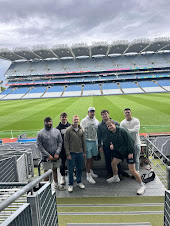More Than a Game: Exploring Gaelic Sports & Culture in Dublin’s Croke Park
Day 4
After leaving Limerick in the morning, we made our way to Dublin to visit the headquarters of the Gaelic Athletic Association (GAA), Croke Park. Most of us had heard of it, but we did not realize how important it is to Irish culture until we were standing inside the 82,300-capacity venue. This was not just a tour of a sports venue. It was an experience that gave us a deeper look at Ireland’s national pride and identity surrounding traditional GAA sports (hurling, camogie, and Gaelic football).
We started with the skyline tour, which is a fenced-in path on the roof of the stadium overlooking Dublin and Croke Park. Some people in the group, including Dr. Varao and “I hate heights” ~Miles Kaplan, have a fear of heights. However, they were brave enough to do the overlook (pictured below) where the skyline tour stretches out from the roof and over the field.
Toward the end of the Skyline Tour, a giant rain cloud attacked us to which Sarah, one of guides from Mary I said “You have to laugh at the rain here, otherwise you’ll cry".
Following the skyline tour, we had a guided tour of the stadium and were immediately impressed by its size and atmosphere. Walking through the player tunnel (pictured below) and stepping out to the pitch helped us understand the immense size of the venue.
The GAA athletes train and compete, not for money, but out of love for the game and their communities. However, our guide explained that although Gaelic football and Hurling are technically amateur sports (the largest amateur sports organization in the world actually), the passion of the athletes and fans is anything but.
Next, we explored the GAA Museum inside Croke Park. It was packed with old gear, jerseys, photos, and videos that showed how much Gaelic sports have evolved. It even had a signed pair of shorts and gloves from when Muhammed Ali fought a match at Croke Park.
There were also interactive stations where we could try out skills like striking a sliotar or kicking a football. It gave us a fun, hands-on way to appreciate just how skilled GAA players are. One of the most powerful parts of the day was learning about the Bloody Sunday Massacre of 1920 when British forces opened fire on fans during a match at Croke Park. Standing at the location of the massacre over 100 years later was impactful.
Visiting Croke Park furthered our understanding of the GAA and its profitability. We learned that Croke Park is completely full at least four times a year, if not more, for the men’s and women’s All-Ireland GAA finals and other events such as major concerts. For lower status GAA games, the stadium regularly reaches at least half-capacity.
Bringing in that many fans for GAA games has an incredibly positive impact on the economy of Dublin and Ireland as a whole.
The people of Ireland typically grow up playing GAA sports at their local town clubs. This gives everyone a connection to their community and their county teams. In fact, many people have connections with county players and All-Ireland referees because they grew up playing with them in local clubs. The personal aspect of GAA sports fosters community in Ireland and consistently draws in fans from all over the country for the All-Ireland tournament and regular season games. The inclusive and accessible nature of the GAA is what makes the association so profitable and popular. The GAA slogan on the wall at Croke Park (pictured below) perfectly captures the unique welcoming nature of the GAA.
Authors: Jason Fisher and Sunshine Clark
Daily Student Leaders, Day 4







Comments
Post a Comment